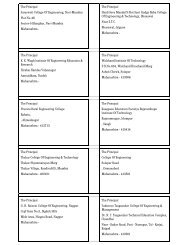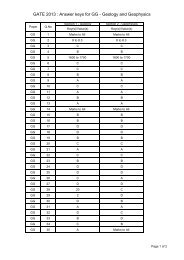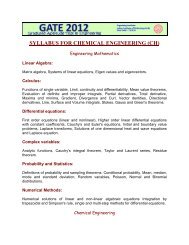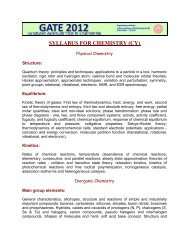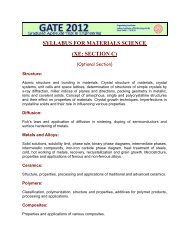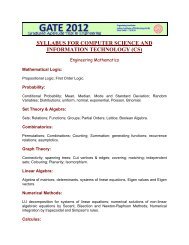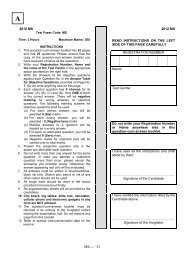XE Section G - GATE-JAM Office
XE Section G - GATE-JAM Office
XE Section G - GATE-JAM Office
You also want an ePaper? Increase the reach of your titles
YUMPU automatically turns print PDFs into web optimized ePapers that Google loves.
SYLLABUS FOR FOOD TECHNOLOGY<br />
Food Chemistry and Nutrition:<br />
(<strong>XE</strong>: SECTION G)<br />
(Optional <strong>Section</strong>)<br />
Carbohydrates: Structure and functional properties of mono- oligo-polysaccharides<br />
including starch, cellulose, pectic substances and dietary fibre; Proteins: Classification<br />
and structure of proteins in food; Lipids: Classification and structure of lipids, Rancidity<br />
of fats, Polymerization and polymorphism; Pigments: Carotenoids, chlorophylls,<br />
anthocyanins, tannins and myoglobin; Food flavours: Terpenes, esters, ketones and<br />
quinones; Enzymes: Specificity, Kinetics and inhibition, Coenzymes, Enzymatic and<br />
non-enzymatic browning; Nutrition: Balanced diet, Essential amino acids and fatty acids,<br />
PER, Water soluble and fat soluble vitamins, Role of minerals in nutrition, Antinutrients,<br />
Nutrition deficiency diseases.<br />
Food Microbiology:<br />
Characteristics of microorganisms: Morphology, structure and detection of bacteria,<br />
yeast and mold in food, Spores and vegetative cells; Microbial growth in food: Intrinsic<br />
and extrinsic factors, Growth and death kinetics, serial dilution method for quantification;<br />
Food spoilage: Contributing factors, Spoilage bacteria, Microbial spoilage of milk and<br />
milk products, meat and meat products; Foodborne disease: Toxins produced by<br />
Staphylococcus, Clostridium and Aspergillus; Bacterial pathogens: Salmonella, Bacillus,<br />
Listeria, Escherichia coli, Shigella, Campylobacter; Fermented food: Buttermilk, yoghurt,<br />
cheese, sausage, alcoholic beverage, vinegar, sauerkraut and soya sauce.<br />
Food Products Technology:<br />
Processing principles: Canning, chilling, freezing, dehydration, control of water activity,<br />
CA and MA storage, fermentation, hurdle technology, addition of preservatives and<br />
food additives, Food packaging, cleaning in place and food laws.; Grain products<br />
processing: Milling of rice, wheat, and maize, parboiling of paddy, production of bread,<br />
biscuits, extruded products and breakfast cereals, Solvent extraction, refining and<br />
hydrogenation of oil; Fruits, vegetables and plantation products processing: Extraction,<br />
clarification concentration and packaging of fruit juice, Production of jam, jelly,<br />
marmalade, squash, candies, and pickles, pectin from fruit waste, tea, coffee, chocolate<br />
and essential oils from spices; Milk and milk products processing: Pasteurized and<br />
sterilized milk, cream, butter, ghee, ice-cream, cheese and milk powder; Animal
products processing: Drying and canning of fish, post mortem changes, tenderization<br />
and freezing of meat, egg powder.<br />
Food Engineering:<br />
Mass and energy balance; Momentum transfer: Flow rate and pressure drop<br />
relationships for Newtonian fluids flowing through pipe, Characteristics of non-<br />
Newtonian fluids - generalized viscosity coefficient and Reynolds number, Flow of<br />
compressible fluid, Flow measurement, Pumps and compressors; Heat transfer: Heat<br />
transfer by conduction, convection, radiation, boiling and condensation, Unsteady state<br />
heat transfer in simple geometry, NTU- effectiveness relationship of co-current and<br />
counter current double pipe heat exchanger; Mass transfer: Molecular diffusion and<br />
Fick's Law, Steady state mass transfer, Convective mass transfer, Permeability of films<br />
and laminates; Mechanical operations: Energy requirement and rate of operations<br />
involved in size reduction of solids, high pressure homogenization, filtration,<br />
centrifugation, settling, sieving, flow through porous bed, agitation of liquid, solid-solid<br />
mixing, and single screw extrusion; Thermal operations: Energy requirement and rate of<br />
operations involved in process time evaluation in batch and continuous sterilization,<br />
evaporation of liquid foods, hot air drying of solids, spray and freeze-drying, freezing<br />
and crystallization; Mass transfer operations: Properties of air-water vapor mixture;<br />
Humidification and dehumidification operations.





